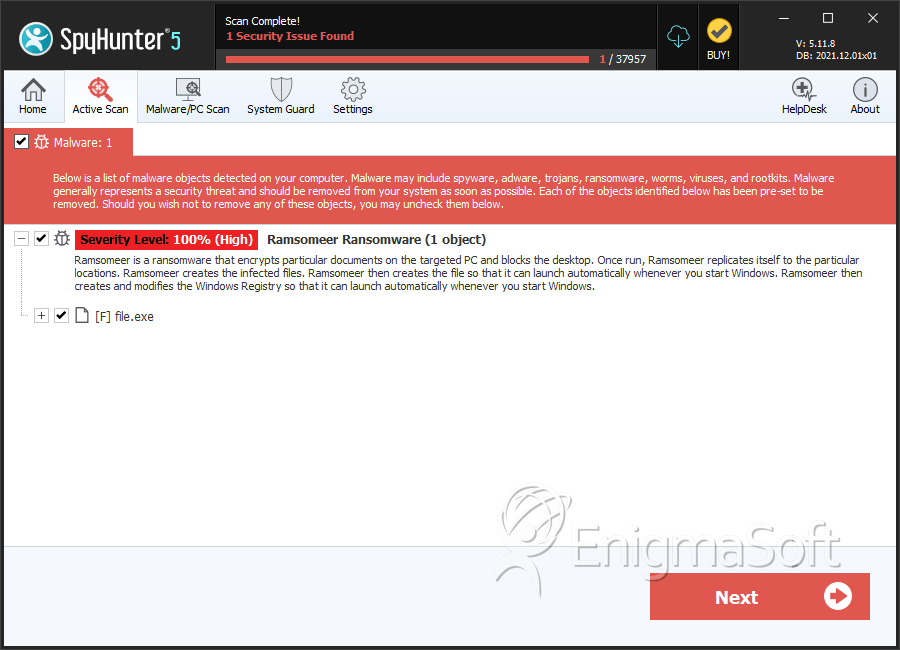Ramsomeer Ransomware
The Ramsomeer Ransomware is part of a large family of encryption ransomware Trojans. The Ramsomeer Ransomware is designed to encrypt the victim's files to demand a ransom. As with most threats of this type, the best measure to deal with the Ramsomeer Ransomware is to take preventive actions such as using a reliable security application and having backups of all files on an external memory device. The Ramsomeer Ransomware represents a danger to the computer users' data, and steps should be taken to prevent the Ramsomeer Ransomware infections, as well as other ransomware Trojan attacks.
Table of Contents
The Ramsomeer Ransomware Trojan may be a Creation of Turkish Hackers
The Ramsomeer Ransomware seems to have been created by Turkish hackers or target computer users in Turkey. This is because the Ramsomeer Ransomware's ransom note is delivered in both English and Turkish. There is still not much known about the Ramsomeer Ransomware, although it is clear that the Ramsomeer Ransomware carries out a typical ransomware Trojan attack. Fortunately, the Ramsomeer Ransomware is still in the early stages of its attack, and very few confirmed Ramsomeer Ransomware attacks have been reported. However, the Ramsomeer Ransomware is just one of countless encryption ransomware Trojans that are active in the wild today.
The Ramsomeer Ransomware uses the AES encryption to make the victim's data completely inaccessible. PC security analysts have also received reports of connections between the Ramsomeer Ransomware and DUMB, a threat designed to target Android-based devices. DUMB is designed to lock mobile phones and change their PINs to prevent computer users from having access to their own mobile device. It is likely that the creators of DUMB and the people behind the Ramsomeer Ransomware attack are the same. DUMB is currently only targeting computer users in the United States, while the Ramsomeer Ransomware attack has been observed in various geographical locations.
How the Ramsomeer Ransomware Attacks Work
It seems that there is very little to differentiate the Ramsomeer Ransomware from other typical ransomware attacks. The Ramsomeer Ransomware is designed to encrypt the victims' files using a strong encryption method. Once the Ramsomeer Ransomware carries out its attack, the victim's files become completely inaccessible. Essentially, the Ramsomeer Ransomware has taken the victim's files hostage, preventing the victim from accessing his or her own data. The Ramsomeer Ransomware delivers a ransom note that threatens the victim and asks for a payment of 0.3 BitCoin (currently approximately $300 USD at the current exchange rate) in exchange for the decryption key that is necessary to recover the affected files.
Dealing with the Ramsomeer Ransomware
It is not a good idea to pay the Ramsomeer Ransomware's ransom amount. It is clear due to the Ramsomeer Ransomware's connections to DUMB that the people responsible for the Ramsomeer Ransomware attacks have no intention of helping computer users recover their files. This is very common; when computer users pay these ransoms, it is not unusual for the extortionists to ignore the victim or ask for more money. Unfortunately, once the victim's files have been encrypted, the damage is already done. Even if the Ramsomeer Ransomware is removed with a reliable security program, the victim's files will remain encrypted. This is why taking preventive measures is so important when it comes to ransomware Trojans.
The following are preventive measures that can help computer users minimize the damage from a the Ramsomeer Ransomware attack, as well as protect their computers from other encryption ransomware Trojans:
- The best preventive measure is to have backups of all files. Having backups of important files negates encryption ransomware Trojans' attacks completely since computer users can recover their files from the backup quickly.
- A reliable security program should be installed, to intercept the Ramsomeer Ransomware infection and other ransomware Trojans as they are being installed.
- The most common distribution method for this threat is corrupted spam email attachments. Computer users should always avoid opening unsolicited email attachments.
SpyHunter Detects & Remove Ramsomeer Ransomware

File System Details
| # | File Name | MD5 |
Detections
Detections: The number of confirmed and suspected cases of a particular threat detected on
infected computers as reported by SpyHunter.
|
|---|---|---|---|
| 1. | file.exe | d9eba5d7d790ee4d6550c141d2df84e6 | 0 |


Submit Comment
Please DO NOT use this comment system for support or billing questions. For SpyHunter technical support requests, please contact our technical support team directly by opening a customer support ticket via your SpyHunter. For billing issues, please refer to our "Billing Questions or Problems?" page. For general inquiries (complaints, legal, press, marketing, copyright), visit our "Inquiries and Feedback" page.